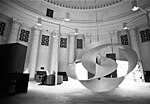TV Man or Five Piece Cube with Strange Hole
1993 sculpturesGranite sculptures in MassachusettsMassachusetts Institute of Technology campusMassachusetts sculpture stubsOutdoor sculptures in Cambridge, Massachusetts
TV Man or Five Piece Cube with Strange Hole is a 1993 mountain rose colored granite and steel sculpture by David Bakalar, installed on the Massachusetts Institute of Technology (MIT) campus, in Cambridge, Massachusetts, United States. The five abstract, organic elements of the sculpture reflect the influences of Constructivism and Surrealism on the artist's style. The geometric forms use negative space to help compose an anthropomorphic ensemble.
Excerpt from the Wikipedia article TV Man or Five Piece Cube with Strange Hole (License: CC BY-SA 3.0, Authors).TV Man or Five Piece Cube with Strange Hole
Memorial Drive, Cambridge Cambridgeport
Geographical coordinates (GPS) Address Nearby Places Show on map
Geographical coordinates (GPS)
| Latitude | Longitude |
|---|---|
| N 42.358885 ° | E -71.089064 ° |
Address
TV Man or Five-Piece Cube with Strange Hole
Memorial Drive
02142 Cambridge, Cambridgeport
Massachusetts, United States
Open on Google Maps










